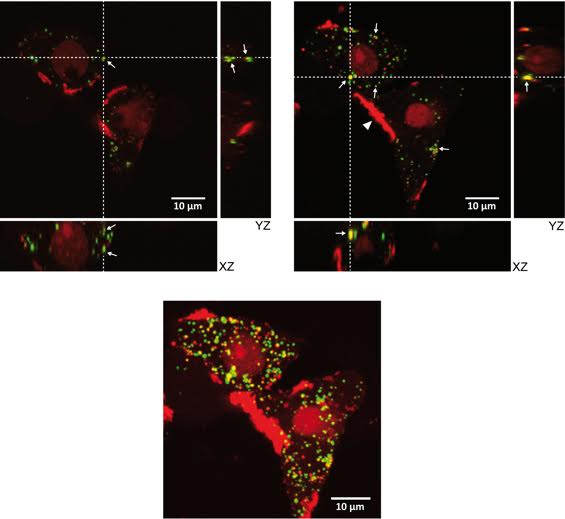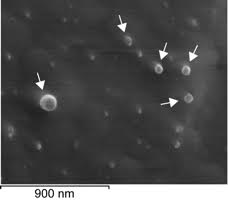RECENT PUBLICATIONS: Delivery of Splice Switching Oligonucleotides by Amphiphilic Chitosan-Based Nanoparticles
INEB researchers recently published an article in the journal Molecular Pharmaceutics, available since December 24th 2015. The article is entitled "Delivery of Splice Switching Oligonucleotides by Amphiphilic Chitosan-Based Nanoparticles" and is authored by Pedro M.D. Moreno, Joyce C. Santos, Carla P. Gomes, Aida Varela-Moreira, Artur Costa, Victoria Leiro, Herman Mansur and Ana P. Pêgo.

Fig.1_Live cell imaging by confocal laser scanning microscopy. TMC-SA/Cy5-SSO complexes (represented in red) at N/P 80 and 70 kDa Rhodamine-Dextran (represented in green) were co-incubated with HeLa/Luc705 cells for 24 h. After extensive washing with PBS, OPTIMem (no phenol red) was added to the wells and cells were imaged. The two orthogonal view images (top) of the same cell represent different xyz coordinates (dashed lines indicate the xy, xz, yz planes of view). Arrows point to examples of co-localization of dextran and Cy5-SSO (identified by appearance of yellow color). Arrowhead points to a region of accumulation of TMC-SA/Cy5-SSO complexes at the cell membrane. The lower image represents a maximum intensity z-projection of 15 slices giving an overview of the vesicle spread throughout the cell and the aggregation of Cy5-SSO polyplexes at the periphery of the cell. Co-localization spots, in yellow, are present in high amounts as observed in the z-projection and confirmed through the orthogonal view analysis.
Splice switching oligonucleotides (SSOs) are a class of single-stranded antisense oligonucleotides (ssONs) being used as gene therapeutics and demonstrating great therapeutic potential. The availability of biodegradable and biocompatible delivery vectors that could improve delivery efficiencies, reduce dosage, and, in parallel, reduce toxicity concerns could be advantageous for clinical translation. In this work we explored the use of quaternized amphiphilic chitosan-based vectors in nanocomplex formation and delivery of splice switching oligonucleotides (SSO) into cells, while providing insights regarding cellular uptake of such complexes.

Fig.2_Cryo-SEM image of transfection competent TMC-SA/SSO polyplexes at N/P ratio 80. White arrows indicate polyplexes. A mostly regular spherical morphology can be observed.


